Escape Goat 2 makes some significant improvements over its predecessor in terms of aesthetics and content, but wisely doesn’t shy too far away from the original formula. With over 100 rooms in the main campaign alone and a perfect blend of action, puzzle solving, and a humorously serious tone wrapped around its ridiculous premise, Escape Goat 2 is a significant improvement over its already rather good predecessor and it is sure to please newcomers to the action puzzle genre and veterans alike.
For those unfamiliar with the series, let’s go over the basics. The world of Escape Goat 2 is a dark and very Gothic setting filled with magic and machinery, not all that dissimilar from the world of Castlevania. It takes itself quite seriously from the stained glass level select screen to the Latin chorus during the credits, but with one obvious catch which makes the whole setting wonderfully ridiculous – the characters are all completely ordinary, non-anthropomorphized animals like sheep, mice, and the titular ‘escape goat’ protagonist. Add in a mix of writing which deliberately and effortlessly bounces between being far too serious and not taking itself seriously at all without ever outright nodding and winking at the player and the result is one of the most outstandingly quirky settings around.
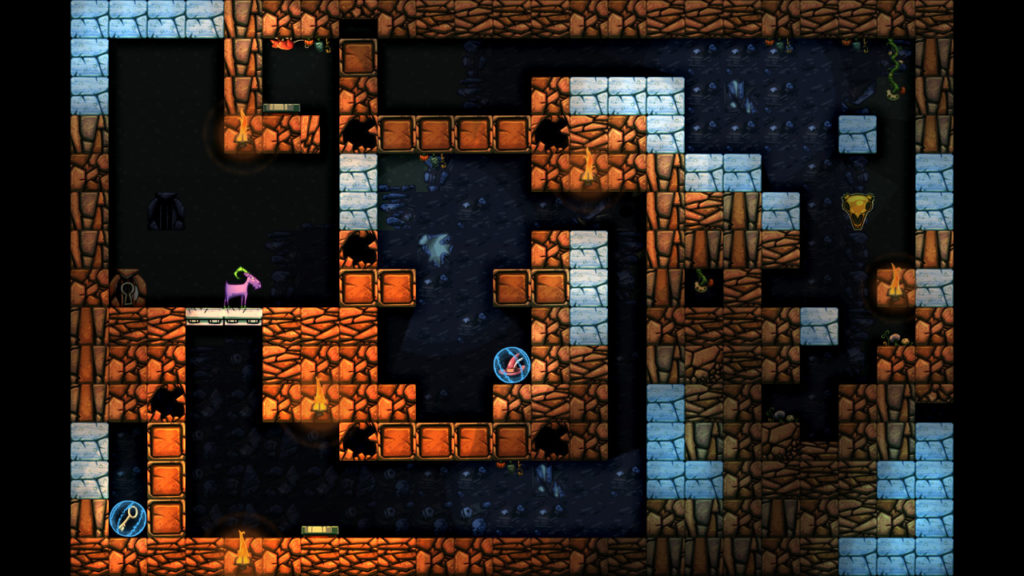
The premise here is that several sheep have wandered into and subsequently become lost or trapped within a mysterious tower and it is up to our purple protagonist to save them and find a way out of the tower in the process. Thus, the map is made of many interconnected single-screen levels with the main spine of the tower forming a vertical hub from which various side regions can be entered in order to find the sheep. You can easily warp to any level which you’ve already completed and you have some control over the order in which you tackle the regions, though upper floors of the tower will periodically be blocked off until a specified number of sheep have been rescued. Each region initially consists of four proper levels plus a final room containing the sheep, but reaching the top of the tower once is only the start of the journey as doing so will unlock an additional five rooms and yet another sheep room in every region, making this a game with a very loose order of progression even before secret levels are taken into account.
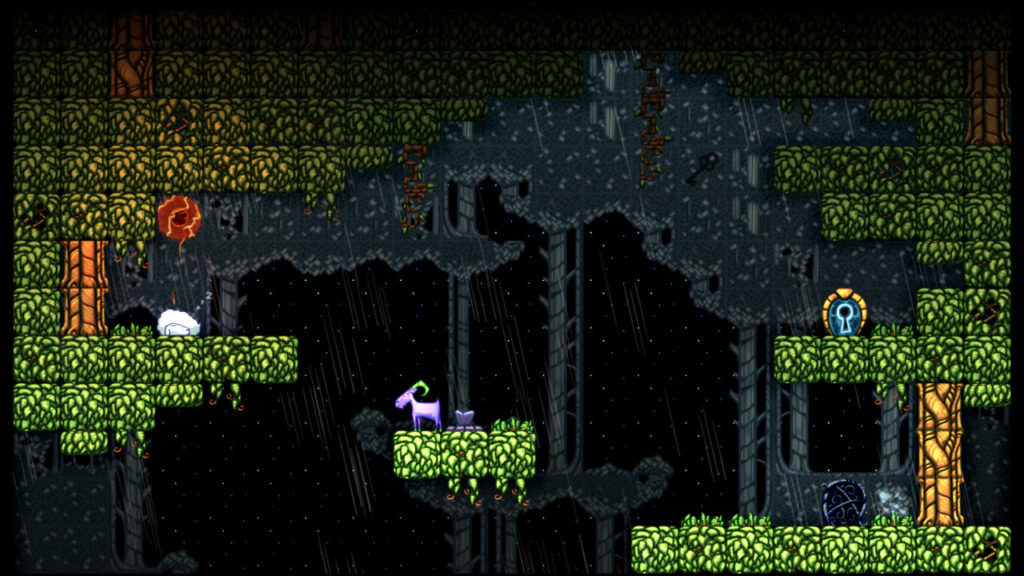
The goal of any given level is to collect every key before making your way to the exit door and you have some rather interesting and useful abilities at your disposal. In addition to having a double jump, the goat is also in possession of a horizontal dash which can be performed on the ground or in the air. If the dash is used in the air it can’t be used again until you land on solid ground, but it is a very flexible ability as it can be used at any time regardless of how many jumps have been used. Even more importantly, you don’t lose any vertical height while dashing so it is easy to perform complicated platforming maneuvers such as jumping to below a ledge, dashing to get out from underneath it without losing any height, and then making use of the second jump to land on top of the platform.
You’re not alone in your journey either as you are aided by a magical mouse. This mouse can be summoned or dismissed at the push of a button and can be tossed downward to remain in a specific location or tossed at a wall to make it continuously scurry in circles across a surface. The mouse is vulnerable to hazards and enemies and it cannot walk on slippery surfaces, but it can run through small crevices which the goat cannot in order to reach switches or other important objects. The amount of mobility you have at your disposal allows for an astonishing amount of freedom in deciding how you approach each platforming challenge while the mouse serves as a highly flexible puzzle-solving tool, which combine to make this one of the few puzzle games which multiple solutions for a large number of its puzzles. Each level has an intended solution to it, but some fast and very precise platforming or some quick thinking with the mouse can often turn a seemingly failed attempt into a surprising and satisfying success.
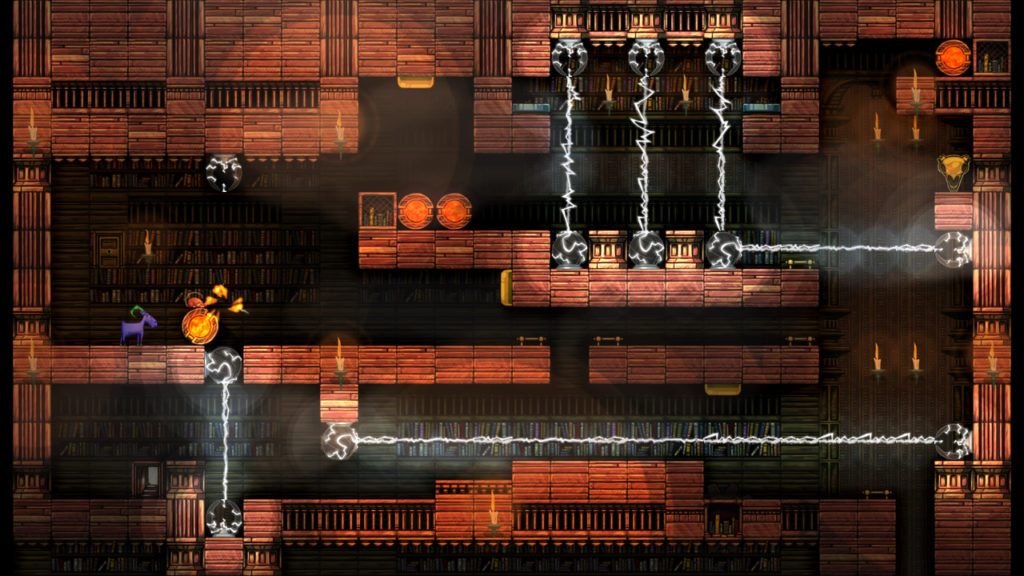
There is often a high amount of complexity packed into each single-screen level. Switches come in two forms, yellow switches which do something the moment they are pressed and which may or may not be linked to each other to serve as a toggle and silver switches which only affect something while being held down and which often come in sets of two or more which all need to be held down simultaneously to work. Looking out for gears and tracks embedded in the walls can help you figure out what each switch will affect in advance, but sometimes it is best to just press everything you can and see what happens before resetting the level. From wooden blocks which can be burnt or smashed to explosive rolling barrels and movable ice blocks which can be melted, all sorts of blocks exist which can as easily help as they hinder.
Learning the rules for each type of block is particularly important because Escape Goat 2 is a game where nearly everything exists for a reason and figuring out the purpose behind the placement of each block is often the key to piecing together the solution to a puzzle. For example, an ice block embedded in a wall usually will serve little purpose beyond forcing the mouse to turn around because it is too slippery, which in turn means that there is probably a reason to want to use the mouse on that wall and figuring out what that reason could logically be might lead to realizing exactly which sequence of actions needs to be taken in order to solve the puzzle. Likewise, even the more lethal elements of each level have their uses. The only enemy type in the game is a scythe-wielding reaper-like creature which patrols back and forth and launches fireballs if the goat or the mouse is lined up with it, which means that this enemy can be used for all sorts of things from pressing switches to igniting crates to melting ice blocks. Sure, sometimes an enemy or another hazard, such as spinning razor blades which run circuits around the walls, really is just there to be a lethal obstacle, but even in these cases they can be useful as taking a moment to reflect upon why you should care about the exact location in which a hazard is positioned is yet another way to figure out puzzle solutions.

On top of everything else, some levels also include collectible powers for the mouse. The magic hat is an old staple from the first game which allows for even more freedom of mobility by allowing the mouse and the goat to swap places at will while creating a magical trail between their locations which kills enemies and destroys certain blocks. A magical cape also makes its debut here, allowing the mouse to dash in a straight line from one surface to another while annihilating any hazards and fragile blocks in its path. Yet another mouse power, and one which is criminally underutilized in the campaign, is a staff which allows for the creation of up to four ‘ghost mice’ simultaneously, making for a ridiculously powerful ability which only gets crazier when you realize that it can be combined with the magic hat. The last power, and my personal favorite, is a hammer which allows the mouse to turn into a block at will, which adds in an entirely new layer of versatility as the block can be used to shield the goat from projectiles, to crush enemies and crates, to shield the mouse itself from attacks, or simply as a way of dropping down from one platform to another.
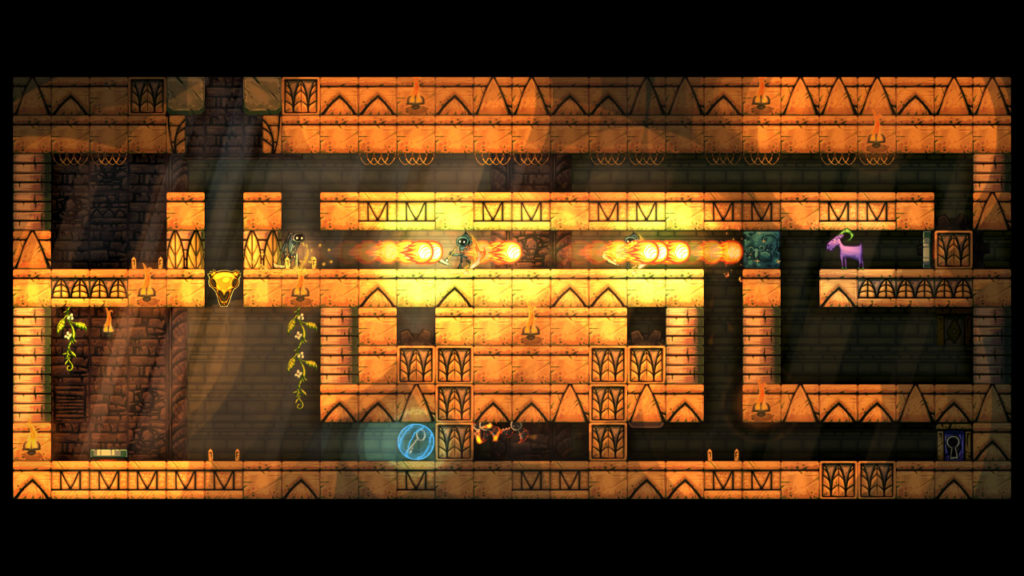
For all the diversity Escape Goat 2 has between its many powers, hazards, and blocks, it does have some trouble with building upon its many ideas. Early staples like exploding barrels and ice blocks are used throughout, but other elements like the staff power and semi-invisible blocks which are only treated as solid by other blocks only appear in a handful of levels before being cast aside forever. The degree to which some elements are underutilized becomes especially noticeable after the second set of levels opens up as at this point players have already been exposed to late-game mechanics like crumbling bone blocks and it would be a good time to start mixing everything together, but these later objects instead remain largely confined to one or two upper regions. On the one hand, this allows each region to maintain a sense of identity beyond its aesthetics and Escape Goat 2 excels at crafting difficult levels from simple elements, yet this sense of each region having a focused identity leads to some missed opportunities for object interactions and it’s rather baffling as to why some elements introduced less than halfway through the game even exist when they ultimately only make appearances in five or so levels. At least the level editor exists to give these elements more time to shine, though the game has been on Steam for almost three years at this point and there are still less than 100 levels in the workshop so chances are high that if you want to play through a level which combines your favorite mechanics you’ll have to make it yourself.
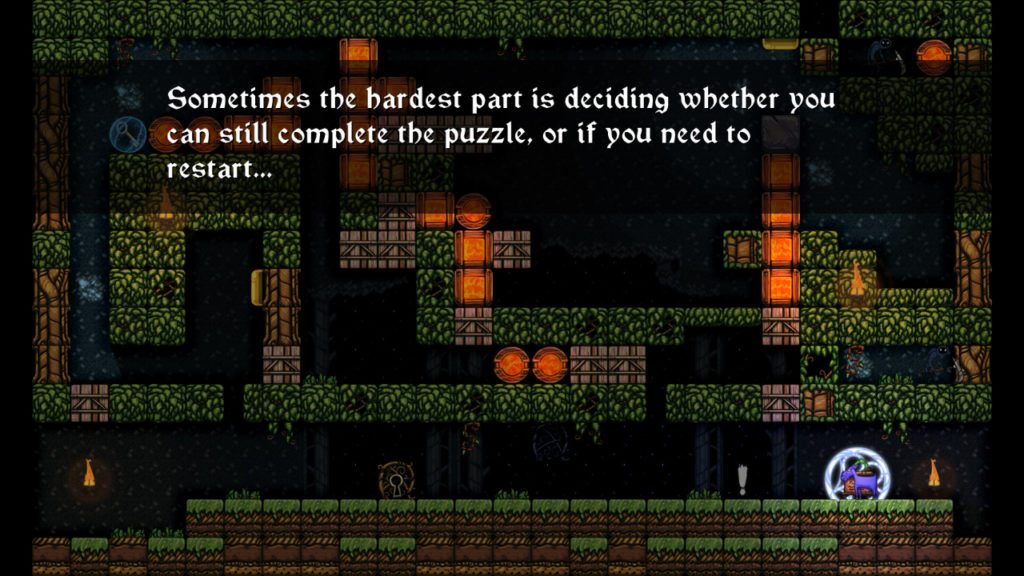
Even though it shies away from making full use of and combining some of its more unusual and complicated level elements, Escape Goat 2 is a top-tier puzzle platformer. Early puzzles start easy, but the difficulty steadily increases right up to the very end, making for a gaming experience which just about anyone can be entertained and challenged by regardless of their familiarity with the genre. The setting stands out simply by putting a quirky twist on tired clichés and it is aided greatly by the aesthetics, which are leaps and bounds above those found in the first game. Replayability is a rare trait in a puzzle game, but it’s present here due to just how flexible puzzle solutions can be and the game even plays with this flexibility by hiding the entrances to secret levels within obscure corners of the normal levels. In short, Escape Goat 2 is a fantastic sequel which improves and expands upon the original in virtually every way while also being an all-around great game in general.